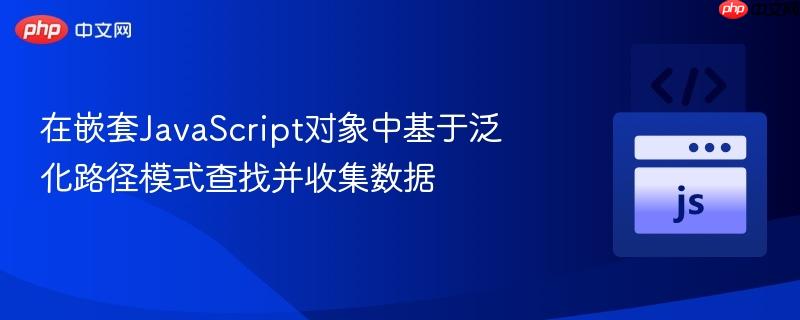
本文详细介绍了如何在深度嵌套的javascript对象中,首先定位到特定文本的精确路径,然后将其泛化为包含数组索引通配符的模式路径。接着,利用此泛化路径模式遍历整个对象结构,高效地收集所有符合该模式的字段值。教程将通过两个核心递归函数实现这一复杂的数据查找与收集任务。
在处理复杂或深度嵌套的JavaScript数据结构时,我们经常需要根据特定条件查找数据。有时,需求不仅仅是找到一个匹配项,而是要识别出该匹配项的结构路径,并基于此路径模式(例如,忽略数组的具体索引)收集所有结构相似的数据。本文将介绍一种两阶段方法来实现这一目标:首先,定位到目标字符串的路径并将其泛化;其次,依据这个泛化路径模式遍历对象,收集所有匹配的值。
传统的对象路径通常是精确的,例如 .a[0].b.c[0].value。然而,在某些场景下,我们可能希望将数组索引视为通配符,即 .a[ANY_INDEX].b.c[ANY_INDEX].value。这种将具体数组索引替换为通配符(例如使用数字 0 作为占位符)的路径,我们称之为“泛化路径模式”。
本方案分为两个主要步骤:
findPath 函数:定位并生成泛化路径
立即学习“Java免费学习笔记(深入)”;
collect 函数:依据泛化路径模式收集数据
为了更好地说明,我们使用以下示例数据:
const obj = {
a: [
{ b: { c: [{ value: 'A' }] } },
{ b: { c: [{ foo: 1 }, { value: 'B' }] } },
{
b: {
c: [{
value: 'C',
b: {
c:
[{ value: 'D' }]
}
}]
}
}
],
a1: [
{ b: { c: [{ value: 'A1' }] } },
{ b: { c: [{ foo: 1 }, { value: 'B1' }] } },
{
b: {
c: [{
value: 'C1',
b: {
c:
[{ value: 'D1' }]
}
}]
}
}
],
};假设我们想要查找字符串 'A',其精确路径是 .a[0].b.c[0].value。我们期望收集所有符合泛化路径 .a[ANY_INDEX].b.c[ANY_INDEX].value 的值。根据示例数据,期望结果是 ['A', 'B', 'C']。
此函数通过深度优先搜索遍历对象。当它遇到一个数组时,会将路径中的对应部分标记为 0,作为数组索引的通配符。
/**
* 递归查找目标字符串的泛化路径。
* @param {object|Array} currentObj 当前要搜索的对象或数组。
* @param {string} targetStr 目标字符串。
* @param {Array<string|number>} currentPath 当前累积的路径片段。
* @param {boolean} isParentArray 标识当前 currentObj 是否为父级数组的元素。
* @returns {Array<string|number>|undefined} 找到的泛化路径数组,如果未找到则返回 undefined。
*/
function findPath(currentObj, targetStr, currentPath = [], isParentArray = false) {
// 遍历当前对象的键值对
for (const [key, val] of Object.entries(currentObj)) {
// 构建当前节点的路径。如果父级是数组,则使用0作为索引占位符;否则使用键名。
const pathSegment = isParentArray ? 0 : key;
const newPath = currentPath.concat(pathSegment);
// 检查值是否为对象或数组,如果是,则继续递归搜索
const isChildArray = Array.isArray(val);
const isChildObject = typeof val === 'object' && val !== null && !isChildArray;
if (isChildArray || isChildObject) {
const foundPath = findPath(val, targetStr, newPath, isChildArray);
if (foundPath) {
return foundPath; // 如果在子结构中找到,则直接返回
}
} else if (typeof val === 'string' && val.includes(targetStr)) {
// 如果当前值是字符串且包含目标字符串,则返回当前构建的路径
return newPath;
}
}
return undefined; // 未找到
}findPath 函数说明:
此函数根据 findPath 生成的泛化路径模式,遍历整个对象,收集所有匹配的值。
/**
* 依据泛化路径模式收集对象中的值。
* @param {object|Array} currentObj 当前要搜索的对象或数组。
* @param {Array<string|number>} remainingPath 待匹配的剩余路径片段。
* @param {Array<any>} collected 收集到的值数组。
*/
function collect(currentObj, remainingPath, collected) {
// 如果路径已匹配完,且当前对象是一个有效值,则将其添加到收集结果中
if (remainingPath.length === 0) {
// 确保当前obj是实际的值而不是一个中间对象/数组
if (typeof currentObj !== 'object' || currentObj === null) {
collected.push(currentObj);
} else if ('value' in currentObj) { // 假设目标值在一个名为'value'的字段中
collected.push(currentObj.value);
}
return;
}
const nextPathSegment = remainingPath.shift(); // 取出路径的下一个片段
// 如果下一个路径片段是0(数组索引通配符)且当前对象是数组
if (nextPathSegment === 0 && Array.isArray(currentObj)) {
for (const item of currentObj) {
// 对数组中的每个元素,都尝试匹配剩余路径
collect(item, remainingPath.slice(), collected); // 使用 slice() 复制路径,避免相互影响
}
return;
}
// 如果下一个路径片段是键名且当前对象是对象,并且该键存在
if (typeof nextPathSegment === 'string' && typeof currentObj === 'object' && currentObj !== null && nextPathSegment in currentObj) {
collect(currentObj[nextPathSegment], remainingPath, collected);
return;
}
// 如果路径不匹配,或者键不存在,则停止当前分支的收集
}collect 函数说明:
将这两个函数结合起来,即可实现完整的逻辑:
// 示例数据 (同上)
const obj = {
a: [
{ b: { c: [{ value: 'A' }] } },
{ b: { c: [{ foo: 1 }, { value: 'B' }] } },
{
b: {
c: [{
value: 'C',
b: {
c:
[{ value: 'D' }]
}
}]
}
}
],
a1: [
{ b: { c: [{ value: 'A1' }] } },
{ b: { c: [{ foo: 1 }, { value: 'B1' }] } },
{
b: {
c: [{
value: 'C1',
b: {
c:
[{ value: 'D1' }]
}
}]
}
}
],
};
const targetString = 'A';
// 1. 查找目标字符串的泛化路径
const generalizedPath = findPath(obj, targetString);
if (!generalizedPath) {
console.error(new Error(`目标字符串 "${targetString}" 未找到。`));
} else {
console.log("找到的泛化路径模式:", generalizedPath); // 例如: ['a', 0, 'b', 'c', 0, 'value']
// 2. 依据泛化路径模式收集所有匹配的值
const collectedValues = [];
collect(obj, generalizedPath.slice(), collectedValues); // 复制路径,避免 collect 函数修改原始路径
console.log("收集到的值:", collectedValues); // 预期输出: ['A', 'B', 'C']
}运行结果分析:
对于目标字符串 'A',findPath 函数会返回 ['a', 0, 'b', 'c', 0, 'value']。 collect 函数会使用这个路径模式进行遍历:
通过这种两阶段的泛化路径搜索和收集方法,我们可以灵活而精确地从复杂数据结构中提取所需信息,极大地提高了数据处理的效率和代码的可维护性。
以上就是在嵌套JavaScript对象中基于泛化路径模式查找并收集数据的详细内容,更多请关注php中文网其它相关文章!

每个人都需要一台速度更快、更稳定的 PC。随着时间的推移,垃圾文件、旧注册表数据和不必要的后台进程会占用资源并降低性能。幸运的是,许多工具可以让 Windows 保持平稳运行。

Copyright 2014-2025 https://www.php.cn/ All Rights Reserved | php.cn | 湘ICP备2023035733号